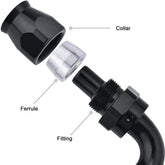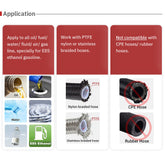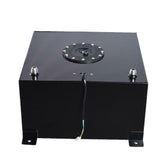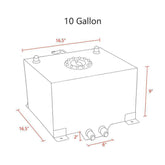An exhaust header, also known as a manifold, is a component of a car's exhaust system that collects exhaust gases from each cylinder and directs them into the exhaust pipe.Typically crafted from metal, it is situated near the engine, playing a pivotal role in upholding a vehicle's performance and efficiency by ensuring proper exhaust flow. Hence, regular maintenance is imperative to avert potential issues.
How to Maintain an Exhaust Header:
Proper upkeep of an exhaust header can extend its longevity and avert major complications. Here are some guidelines for maintaining your exhaust header:
- Regular Inspection and Cleaning: It is essential to inspect your exhaust header regularly for any signs of damage or wear. Look for cracks, rust, or loose connections. If you notice any issues, it is best to address them immediately to prevent further damage. Additionally, cleaning your exhaust header regularly can help remove any built-up dirt or debris that can affect its performance.
- Checking for Leaks and Cracks: Exhaust leaks can cause a decrease in engine performance and can also be a safety hazard. Therefore, it is crucial to check for any leaks or cracks in your exhaust header and get them fixed promptly.
- Replacing Worn Out Gaskets: Gaskets are used to seal the connections between the exhaust header and the engine. Over time, they can wear out and cause leaks. It is essential to replace worn-out gaskets to ensure proper sealing and prevent any potential issues.
- Using High Quality Fuel and Oil: The quality of fuel and oil used in a car can also affect the performance of the exhaust header. Low-quality fuel and oil can cause deposits to build upon the exhaust header, affecting its efficiency. Therefore, it is recommended to use high-quality fuel and oil to maintain the performance of your exhaust header.
Indications for Replacement:
Despite proper maintenance, an exhaust header can wear out over time and may need to be replaced. Here are some signs that indicate it is time to replace your exhaust header:
- Loud Exhaust Noise: If you notice a loud noise coming from your exhaust, it could be a sign of a damaged or worn-out exhaust header. The noise can be caused by leaks or cracks in the header, affecting its performance.
- Diminished Engine Performance: A damaged exhaust header can affect the performance of your engine, resulting in a decrease in power and acceleration. If you notice a significant decrease in your car's performance, it could be due to a faulty exhaust header.
- Visible Damage or Rust: Regularly inspecting your exhaust header can help you identify any visible damage or rust. If you notice any cracks, holes, or rust, it is a clear sign that your exhaust header needs to be replaced.
- Check engine light comes on: A malfunctioning exhaust header can also trigger the check engine light on your dashboard. If the light is on, it is best to get your car checked by a professional to determine the cause.
- Avoiding Excessive Heat and Moisture: Excessive heat and moisture can cause the exhaust header to rust and corrode, leading to potential leaks and cracks. It is essential to avoid driving in extreme weather conditions and to park your car in a dry and cool place to prevent any damage to the exhaust header.
Are there legal or environmental considerations for exhaust header upgrades?
If you are considering upgrading your exhaust header, there are a few led environmental considerations to keep in mind:
- Emissions Regulations: Some states have strict emissions regulations, and upgrading your exhaust header may not be legal. It is essential to check the regulations in your state before making any modifications to your car's exhaust system.
- Noise Pollution Laws: Upgrading your exhaust header can result in a louder exhaust noise, which may not be legal in some areas. It is crucial to check the noise pollution laws in your state before making any changes to your exhaust system.
- Impact on Fuel Efficiency: Upgrading your exhaust header can improve your car's performance, but it can also affect its fuel efficiency. It is essential to consider the potential impact on fuel consumption before making any upgrades.
- Sustainable Alternatives: If you are environmentally conscious, you may want to consider eco-friendly options for your exhaust header. Some brands offer headers made from sustainable materials or with eco-friendly designs that can reduce emissions and improve fuel efficiency.
Conclusion:
In conclusion, maintaining an exhaust header is crucial for the performance and efficiency of a car. Regular inspection, cleaning, and addressing any issues promptly can help prolong its lifespan. Signs of replacement should not be ignored, and it is essential to consider various factors when selecting an exhaust header for your car. Additionally, it is crucial to be aware of any legal or environmental considerations before making any upgrades.
Exhaust header FAQs:
1. Can I replace an exhaust header myself?
It is recommended to have a professional mechanic replace your exhaust header to ensure proper installation and avoid any potential issues.
2. How often should I inspect my exhaust header?
It is recommended to inspect your exhaust header every 6 months or 10,000 miles, whichever comes first.
3. Is it necessary to replace the entire exhaust system when replacing the header?
No, it is not necessary to replace the entire exhaust system unless there are other issues or damage.
4. Can I upgrade my exhaust header for better performance?
Yes, upgrading your exhaust header can improve your car's performance, but it is essential to consider any legal or environmental implications.
5. Are there any eco-friendly options for exhaust headers?
Yes, some brands offer eco-friendly options for exhaust headers, such as sustainable materials or designs that reduce emissions and improve fuel efficiency.









